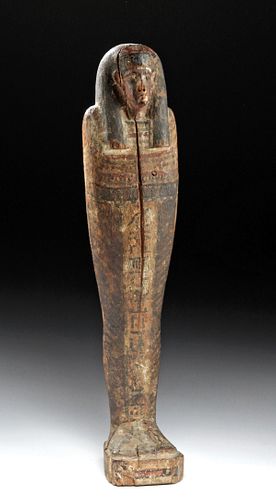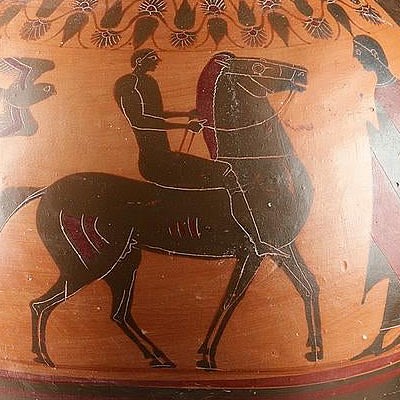Tall Egyptian Painted Gesso Ptah Sokar Osiris Figure
Lot 10b
About Seller
Artemis Fine Arts
686 S Taylor Ave, Ste 106
Louisville, CO 80027
United States
Selling antiquities, ancient and ethnographic art online since 1993, Artemis Gallery specializes in Classical Antiquities (Egyptian, Greek, Roman, Near Eastern), Asian, Pre-Columbian, African / Tribal / Oceanographic art. Our extensive inventory includes pottery, stone, metal, wood, glass and textil...Read more
Categories
Estimate:
$4,000 - $8,000
Absentee vs Live bid
Two ways to bid:
- Leave a max absentee bid and the platform will bid on your behalf up to your maximum bid during the live auction.
- Bid live during the auction and your bids will be submitted real-time to the auctioneer.
Bid Increments
| Price | Bid Increment |
|---|---|
| $0 | $25 |
| $300 | $50 |
| $1,000 | $100 |
| $2,000 | $250 |
| $5,000 | $500 |
| $10,000 | $1,000 |
| $20,000 | $2,500 |
| $50,000 | $5,000 |
| $100,000 | $10,000 |
| $200,000 | $20,000 |
About Auction
By Artemis Fine Arts
Jun 4, 2020
Set Reminder
2020-06-04 10:00:00
2020-06-04 10:00:00
America/New_York
Bidsquare
Bidsquare : Exceptional Antiquities, Asian, Ethnographic
https://www.bidsquare.com/auctions/artemis-gallery/exceptional-antiquities-asian-ethnographic-5185
An important one-day auction featuring museum-worthy examples of Egyptian, Greek, Roman, Etruscan, Near Eastern, Far East / Asian, Pre-Columbian, African / Tribal, Oceanic, Native American, Spanish Colonial, Russian, Fossils, Ancient Jewelry, Fine Art, so much more! Artemis Fine Arts info@artemisfinearts.com
An important one-day auction featuring museum-worthy examples of Egyptian, Greek, Roman, Etruscan, Near Eastern, Far East / Asian, Pre-Columbian, African / Tribal, Oceanic, Native American, Spanish Colonial, Russian, Fossils, Ancient Jewelry, Fine Art, so much more! Artemis Fine Arts info@artemisfinearts.com
- Lot Description
Egypt, Late Dynastic to Ptolemaic periods, ca. 664 to 30 BCE. A hand-carved wooden statue depicting Ptah-Sokar-Osiris in his human-faced form. Figures like this example would have once been part of a larger figurative box for funerary rituals. This is the Osiris portion of the box, shown in mummiform with fused legs and standing atop an integral rectangular plinth, with richly painted gesso surfaces adorned in red, white, black, and blue pigment. He wears an intricate wesekh-collar draped in front of the smooth chest, a vestment with a netted pattern, and a tripartite wig atop his head. The narrow countenance features almond-shaped eyes with elongated canthi, a broad nose, pursed lips, and large ears, all beneath a petite hole meant for holding an original ostrich feather Atef crown. A column of black hieroglyphic inscription courses down both obverse and verso and, while untranslated, provides the names of Osiris and the deceased as well as an incantation from Chapter 6 of the Egyptian Book of the Dead. Size: 3.25" W x 14.375" H (8.3 cm x 36.5 cm).
Ptah Sokar Osiris is one of the most complicated concepts of Egyptian mythology. The figure shown here represents the god's three parts: Ptah, the creator god of Memphis; Sokar, the patron of the Memphite necropolis; and Osiris, the god of the afterlife and lord of the underworld. All three are depicted in mummy forms; Osiris and Ptah as men, and Sokar as a falcon. Osiris is no longer present in this example but would have been kept as a mummy - made of vegetable matter - inside the original coffin-like box. Together, they tell a story of birth, death, and resurrection.
These figures became popular after ca. 1000 BCE and are associated with elite burials. In each, the god stands atop a box with a simple lid; a linen-wrapped mummy made of vegetable matter would be placed into the hollow box to represent rebirth in the afterlife (the earliest examples instead had funerary papyri placed inside of them). This "mummy" was a substitute image of the deceased, and when it sprouted, it would symbolize rebirth. The entire artifact, as this one is, would be painted with rich colors, and decorated with hieroglyphics. Items like these were almost certainly made by priests as part of the funerary ritual. This figure represents the complex religious iconography of ancient Egypt and serves as a good example that this religion and culture was not unchanging over the vast time period that it lasted; instead, new practices and gods arose over time.
A stylistically similar example, of a larger size and with a gilded face, hammered for $40,000 at Christie's, New York "Antiquities" auction (sale 2709, June 6, 2013, lot 676).
Provenance: private J.H. collection, Beaverton, Oregon, USA, acquired in December 2006; ex-Tom Cederlind collection, Portland, Oregon, USA
All items legal to buy/sell under U.S. Statute covering cultural patrimony Code 2600, CHAPTER 14, and are guaranteed to be as described or your money back.
A Certificate of Authenticity will accompany all winning bids.
We ship worldwide and handle all shipping in-house for your convenience.
#149662Feet reattached to bottom of figure, with minor losses and light adhesive residue along break lines. Losses to areas of base, feet, obverse, head, and original Atef crown as shown. Chipping and fading to original pigmentation, light encrustations within some recessed areas, and minor softening to some finer details. Great remains of original pigment throughout.Condition
- Shipping Info
-
All shipping is handled in-house for your convenience. Your invoice from Artemis Gallery will include shipping calculation instructions. If in doubt, please inquire BEFORE bidding for estimated shipping costs for individual items.
-
- Buyer's Premium



 EUR
EUR CAD
CAD AUD
AUD GBP
GBP MXN
MXN HKD
HKD CNY
CNY MYR
MYR SEK
SEK SGD
SGD CHF
CHF THB
THB















